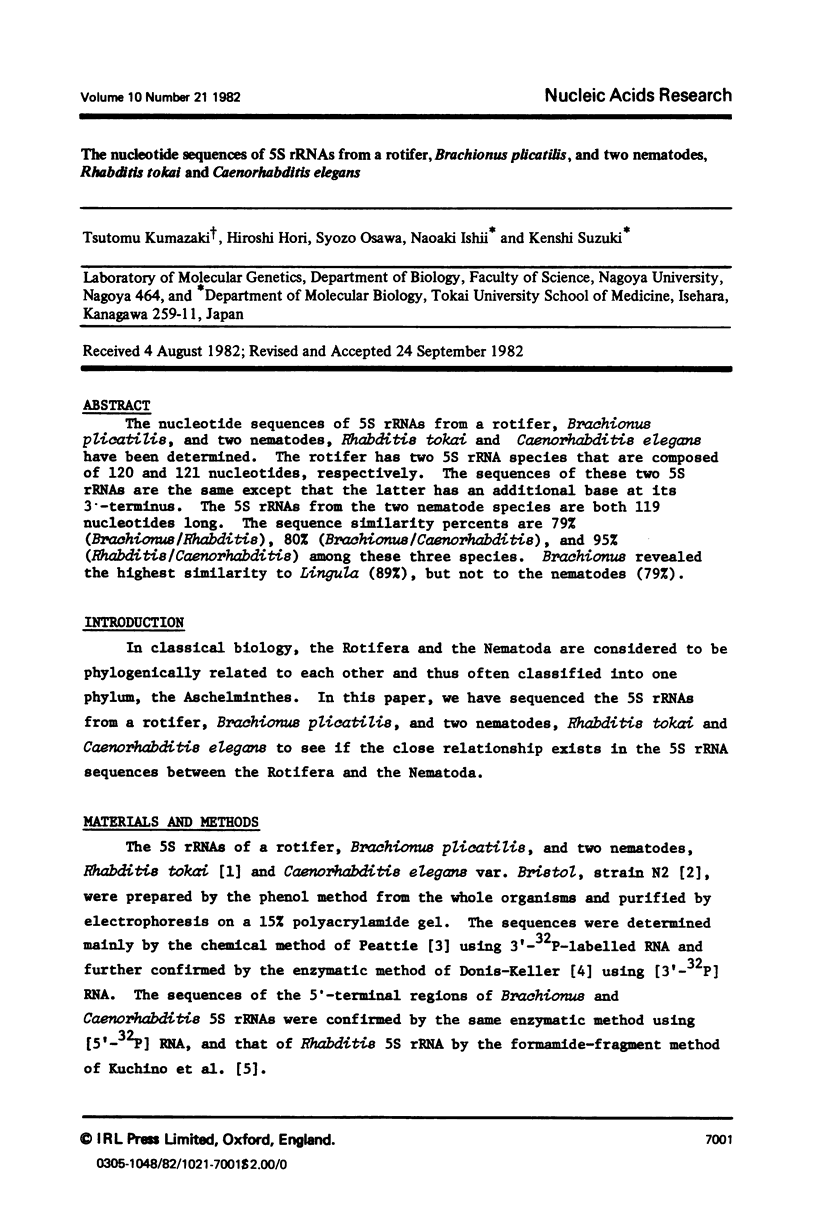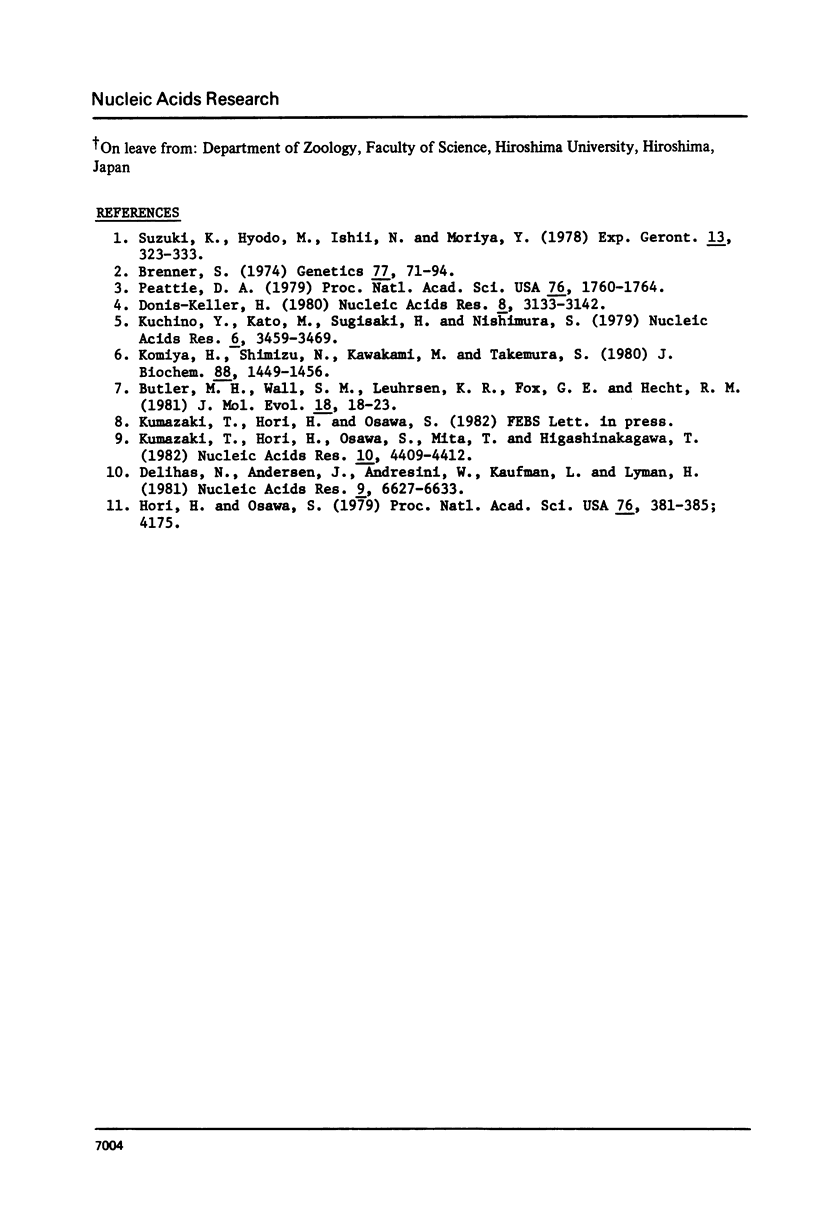Abstract
The nucleotide sequences of 5S rRNAs from a rotifer, Brachionus plicatilis, and two nematodes, Rhabditis tokai and Caenorhabditis elegans have been determined. The rotifer has two 5S rRNA species that are composed of 120 and 121 nucleotides, respectively. The sequences of these two 5S rRNAs are the same except that the latter has an additional base at its 3'-terminus. The 5S rRNAs from the two nematode species are both 119 nucleotides long. The sequence similarity percents are 79% (Brachionus/Rhabditis), 80% (Brachionus/Caenorhabditis), and 95% (Rhabditis/Caenorhabditis) among these three species. Brachionus revealed the highest similarity to Lingula (89%), but not to the nematodes (79%).
Full text
PDF



Selected References
These references are in PubMed. This may not be the complete list of references from this article.
- Brenner S. The genetics of Caenorhabditis elegans. Genetics. 1974 May;77(1):71–94. doi: 10.1093/genetics/77.1.71. [DOI] [PMC free article] [PubMed] [Google Scholar]
- Butler M. H., Wall S. M., Luehrsen K. R., Fox G. E., Hecht R. M. Molecular relationships between closely related strains and species of nematodes. J Mol Evol. 1981;18(1):18–23. doi: 10.1007/BF01733207. [DOI] [PubMed] [Google Scholar]
- Delihas N., Andersen J., Andresini W., Kaufman L., Lyman H. The 5S ribosomal RNA of Euglena gracilis cytoplasmic ribosomes is closely homologous to the 5S RNA of the trypanosomatid protozoa. Nucleic Acids Res. 1981 Dec 11;9(23):6627–6633. doi: 10.1093/nar/9.23.6627. [DOI] [PMC free article] [PubMed] [Google Scholar]
- Donis-Keller H. Phy M: an RNase activity specific for U and A residues useful in RNA sequence analysis. Nucleic Acids Res. 1980 Jul 25;8(14):3133–3142. doi: 10.1093/nar/8.14.3133. [DOI] [PMC free article] [PubMed] [Google Scholar]
- Hori H., Osawa S. Evolutionary change in 5S RNA secondary structure and a phylogenic tree of 54 5S RNA species. Proc Natl Acad Sci U S A. 1979 Jan;76(1):381–385. doi: 10.1073/pnas.76.1.381. [DOI] [PMC free article] [PubMed] [Google Scholar]
- Komiya H., Shimizu N., Kawakami M., Takemura S. Nucleotide sequence of 5S ribosomal RNA from Lingula anatina. A study on the molecular evolution of 5S ribosomal RNA from a living fossil. J Biochem. 1980 Nov;88(5):1449–1456. doi: 10.1093/oxfordjournals.jbchem.a133114. [DOI] [PubMed] [Google Scholar]
- Kuchino Y., Kato M., Sugisaki H., Nishimura S. Nucleotide sequence of starfish initiator tRNA. Nucleic Acids Res. 1979 Aug 10;6(11):3459–3469. doi: 10.1093/nar/6.11.3459. [DOI] [PMC free article] [PubMed] [Google Scholar]
- Kumazaki T., Hori H., Osawa S., Mita T., Higashinakagawa T. The nucleotide sequences of 5S rRNAs from three ciliated protozoa. Nucleic Acids Res. 1982 Jul 24;10(14):4409–4412. doi: 10.1093/nar/10.14.4409. [DOI] [PMC free article] [PubMed] [Google Scholar]
- Peattie D. A. Direct chemical method for sequencing RNA. Proc Natl Acad Sci U S A. 1979 Apr;76(4):1760–1764. doi: 10.1073/pnas.76.4.1760. [DOI] [PMC free article] [PubMed] [Google Scholar]
- Suzuki K., Hyodo M., Ishii N., Moriya Y. Properties of a strain of free-living nematode, Rhabditidae sp.: life cycle and age-related mortality. Exp Gerontol. 1978;13(5):323–333. doi: 10.1016/0531-5565(78)90041-4. [DOI] [PubMed] [Google Scholar]


